States of Matter
States of Matter is a musical composed by Adam Farouk. It explores the restoration and reintegration of a human psyche after it has been shattered by trauma. When an extreme moment of distress triggers a mental breakdown, the psyche fractures into four separate aspects of itself, or "states," who must come to remember their inherent sense of harmony with one another, if the psyche is to heal, and all are to survive.
Characters:
Heart ~ Never one to take no for an answer, the character of "Heart" expresses the psyche's sense of bold and daring adventure. In balance, Heart is the part of us who dares to set grand projects in motion; out of balance, these lofty designs can easily turn into reckless and harmful behavior.
Voice part: Tenor
Music ~ Tumultuous, tempestuous, temperamental, "Music" embodies the psyche's emotional core. With a tendency to seek partnership as an answer to her ills, Music, in balance, can be loyal, harmonious, and a friend to all; out of balance, her stormy energy can easily spiral out of control.
Voice part: Soprano
Rhythm ~ Self-seeking, ambitious and proud, "Rhythm" expresses the psyche's sense of calculation and shrewdness. In balance, Rhythm is the part of us who employs step by step thinking to achieve goals; out of balance, his cold, steely center finds it all too easy to use others as means towards ends.
Voice part: Baritone
Soul ~ Blessed with natural sense of intuition, the character of "Soul" expresses the psyche's capacity for sagacity and transcendence. In balance, Soul's ability to see and appreciate the moment within the moment is equal to none; out of balance, this neutrality can come across detached and aloof.
Voice part: Alto




The Story:
Through story and song, States of Matter explores the restoration and reintegration of a human psyche after it has been shattered by trauma. When an extreme moment of distress triggers a mental breakdown, the psyche fractures into four separate aspects of itself: Heart, its fearless instigator; Rhythm, its shrewd pragmatist; Music, its tumultuous mind; and Soul, its wise inner-sage. Each of these aspects—or “states”—has its strengths, and each has its vulnerabilities, however, none of them can exist without the others, and, moreover, the psyche to which they belong cannot exist divided. The four states must learn to put aside any misgivings, whether feelings of primacy, apprehension, or mistrust, and come to remember their inherent sense of harmony with one another, if they are to come together, the psyche is to heal, and all are to survive.
* * * * *
From the darkness, there emerge four individuals. Identifying themselves, respectively, as: Heart, Music, Rhythm, and Soul, and, collectively, as the four “States of Matter.” Each appears to embody a certain aspect of the human experience: Heart, as its fearless instigator; Rhythm, its shrewd pragmatist; Music, its tumultous mind; and Soul, its wise inner sage. Confident and steadfast in their identities, the four states spend a few minutes extolling their own virtues together (JUST ONE LOOK), before each steps forth to self-elucidate individually.
Heart steps forward first, perhaps unsurprisingly. He draws upon his experiences as an enterprising young professional, just starting out in the world, and sings a song in which he passionately lays out his desires (ANOTHER SUNRISE), which are to win glory and honor through slaying what he calls dragons, which in reality are metaphors for the forces of fear and resistance that he feels are holding him back in life. To Heart there is no second place; if he seems willing to give up his life for this quest, it is because he is. Heart is an optimistic character; while he is competitive, there is little anger in his words, he is merely passionately passionate in every way.
Next, Music steps up. She draws her emotional memory as far back as it can go, all the way to 8000 years BCE, when, as the citizen of a minor kingdom in the Fertile Crescent, she finds her people conquered and enslaved by the one of the great ancient empires. Newly disenfranchised, and forced constantly to give tribute to her overlords, she finds her only solace in singing to herself songs of better times (NO NEED TO HIDE), both past, and, hopefully, future. She grows in confidence through this subtle act of resistance, and while it is implied that she carries the child from a secret affair between her and one of her subjugators, it is clear that her future is by no means written in stone.
Soul is next. She chooses a different approach; instead of using story and metaphor to convey her worldview and aspirations, she opts to do so via the power of transcendence and the use of mantra. She starts a vocalized chant among her comrades, employing it to begin a musical meditation, insisting upon them her belief that participation in such practices is the only way for them to find the answers which they seek (THE FEELING). She urges them to feel a sense of catharsis about their lives, which only reveals her own immaturity, as such things, useful as they are for gaining wisdom, typically cannot be rushed.
Finally, Rhythm presents his treatise. Rhythm recalls a period of his journey, probably somewhere in the late-twentieth century, where he found himself a frustrated creative, in this case a composer, who, rather than being able to write the music in his heart, in order to make ends meet was forced to spend the majority of his waking hours writing jingles for commercials (CALL OF MY LIFE). Heart, Music, and Soul chatter behind him, an irksome greek chorus, haunting and tormenting him as he tries to find his way out of the expectations and duties of his dead-end job. Eventually, through grit and attention, he is able to leave, and answer his life’s call.
Heart and Rhythm, having both made the choice to aggressively pursue their inner desire, find themselves on the front lines of furious war and combat. Heart relives his time as a solder in the trenches of World War One, dying in the heat of battle, becoming one of many unknown soldiers in nameless graves (DREAMING YOUR WAY); Rhythm, on the other hand, fights for the allies in World War Two, expressing a cynical frustration of the notion of glorious combat, and criticizing his cohorts who seek fame and notoriety for their exploits on the battlefield (SOLILOQUY).
Music, reliving through this exercise the trauma, death, and destruction wrought by conflict, finds herself bewildered and seeking to understand why we, collectively, would engage in such behavior. She sings, confused and frustrated, realizing that she has spent too much time looking to others as a means to define herself. Heart appears, a phoenix rising from the ashes, and tries to soften the blow with words of hope and comfort. (WHAT WOULD YOU DO?) In so doing, he is symbolically resurrected as a free spirit, with the chance to ascend to a new plane of existence.
The lights slowly rise on Soul, who, in the wee hours of the early morning, finds herself contemplating life’s paradoxes, and wondering what point there is in gaining wisdom, if we, as a people, are so prone to repeating our mistakes. She sings a powerful ballad (WHEN TOMORROW COMES), a song of epiphany which sees her surrendering to life’s mystery and resigning herself to not-knowing, and to the ambiguity of her life’s experiences. She ends the song feeling at the same time more vulnerable and more powerful.
Act One draws to a close with Rhythm, still frustrated at what he feels are a long string of stymied attempts to achieve his goals and acquire his desires (FIND THE SUN). Music, beset by fear, joins him in harmony; it is a strangely upbeat chorus of doubt and exasperation. Soul and Heart, on the other hand, together lead a melodic counterpoint filled with hope and conviction, though they are just as unsure about their future. Eventually, however, the four are drawn together by spirit, and, facing forward, belt out a powerful intention to the universe, that they will all find what they are looking for, and through so doing will see themselves standing beside, and in the presence of, their inner source and their true power.
~ Intermission ~
Act Two begins with a quick recap of the story so far: Rhythm is still searching, though in a manner he believes indicates that he has turned a new leaf. Music is still confused and doubtful, Soul still believes she possesses all the answers inside, and Heart seems to be reveling in the bevy of new experiences he is experiencing having ascended spiritually (THE LEAP OF FAITH). It’s a peppy moment which reminds us how much this group of four might be capable of if they would only work together.
Heart, no longer bound by his experiential memory alone, channels the energy of Orville Wright into an inspirational fantasy piece (WITH WINGS TO FLY) in which he relives the first flight of a heavier-than-air aircraft in 1903. In it is a powerful message of endurance, perseverance, ingenuity, and grit, but moreover, it is a spiritual farewell from Heart, who believes his mission on this plane to be complete, and is convinced that his time as a “State of Matter” is ending, and that he must now leave, and transition to the next dimension, and the next level of his spiritual development.
Music, feeling wronged by what she perceives as everyone supporting and validating Heart’s choice to leave, presents the opposite point of view, that finding peace within oneself is just as important as journeying through uncharted worlds (TRYING TO FIND SOME PEACE OF MIND). She explores her feelings through song, her confused state giving way, alas, to a forlorn one, as she starts second guessing herself and her choices. Tenuously setting herself the task of facing her stories anew, she disappears into shadow.
Rhythm, on the other hand, is high on life—his new bearing, footloose and fancy free, suits him to a tee. He relives his experience of having been a successful song-and-dance-man in the early-to-mid thirties. Ironically, since experiences in this show do not happen chronologically, we, the audience, already know that, in a few short years, this decorated career will be cut short, when Rhythm is conscripted to serve his country as a soldier. But for now, it’s all smiles, as he sings one of his hit records, a song he made famous and a gift he gave to the world (YOU CAN MAKE ME SMILE).
Secretly stunned by the fact that Heart ascended before she did, Soul is thrown back in time to the middle ages, reliving a humbling experience wherein she, a popular queen of a powerful kingdom, was rejected, and eventually banished, in favor of a younger courtier. As her king heartlessly gives her the news of what duties she is expected to carry out as she leaves, she sings, not just to him, but to her nation as well, a powerful message of inner strength and self-possession (WALKING AWAY), holding her head up tall and standing proud despite the difficult circumstances which surround her.
The four states take part in a variation of the traditional “dream ballet” (SWING); rather than a ballet, however, it is swing dance, that thrusts the story forward and sends it careening towards its climax and resolution. Music is the ad hoc protagonist for this dreamscape; she walks through a terrifying world where all of her greatest fears come to life in dance. She experiences abandonment, abject terror, physical threats, and, eventually, she herself becomes a nightmare image of who she actually is. The moment spirals into chaos, before crescendoing to a high and grinding to a halt. Immediately, all is turned to dark.
Music wakes up, tied to a hospital bed, and in a straight-jacket. Unsure of what’s going on, she fixates on the moments of memory that do present with some clarity. She appears to be a young woman, supremely lacking in self-confidence. She feels like an outsider, the kind who might have intrusive thoughts, thoughts, perhaps, of being violent to herself, perhaps even of killing herself (NOCTURNE). However, at a point in the story, she is haunted by a memory of having been sexually assaulted by a young man of privilege who never paid for his crime. Betrayed by a system that promised her justice, she has a psychotic break. No longer of sound mind, she hatches a plan, and attempts to take her own life.
This cell is her reality now. This hospital bed, the straight-jacket, this is the now that she lives in in reality. These events are what caused her psyche to shatter in the first place. This is what brought these four States of Matter to life.
Heart and Rhythm argue with one another (HERE AND NOW). Both agree that Music is in a delicate psychological state, and that she will fall if nothing is done about her situation. But neither see the situation as theirs to mend. Heart believes that his ascendence will bring the energy of a higher power into play in the psyche in which they share existence, and that doing so will lift the spirits of each of the four states to a better place. Rhythm believes that by focusing on positive memories, and by aligning the collective memory as closely and in parallel with positive past experiences as possible, the psyche will start to feel better about itself, and this will lift each and all of them to a better place. Either way, each believes that his way is right, and the other’s way is sure-fire folly.
Eventually, Soul, tired of their arguing, and enraged by their displays of selfishness, sets them straight with her view of the situation: all four states can only exist together. Apart, they will self-annihilate. They move up, and down, through the spiritual journey, together, or they do not move at all. Heart may think he’s earned the right to move up, but that feeling is nothing if the other three are not ready to ascend, for whatever reason, and the same goes for Rhythm. Moved to tears, she breaks down beside a catatonic Music. Heart and Rhythm, sharing a glance, join their brethen, and the four states hold each other, in their arms, for a few moments.
Soul, gathering herself, tentatively puts forth a few final words and thoughts (RAIN). Her singing inspires Music, and causes her to awaken from her trauma, and rejoin her fellow states in observation, and in song. As they all stand, together for one more moment, before they are merged into a single-consciousness, they vocalize together in powerful and sublime harmony. As the music slowly fades away, they offer their closing thoughts in the form of a rhyming couplet: “I know that someday we will find the sun. To light the day, just like we’ve just begun…” The lights fade to darkness, and the play ends.
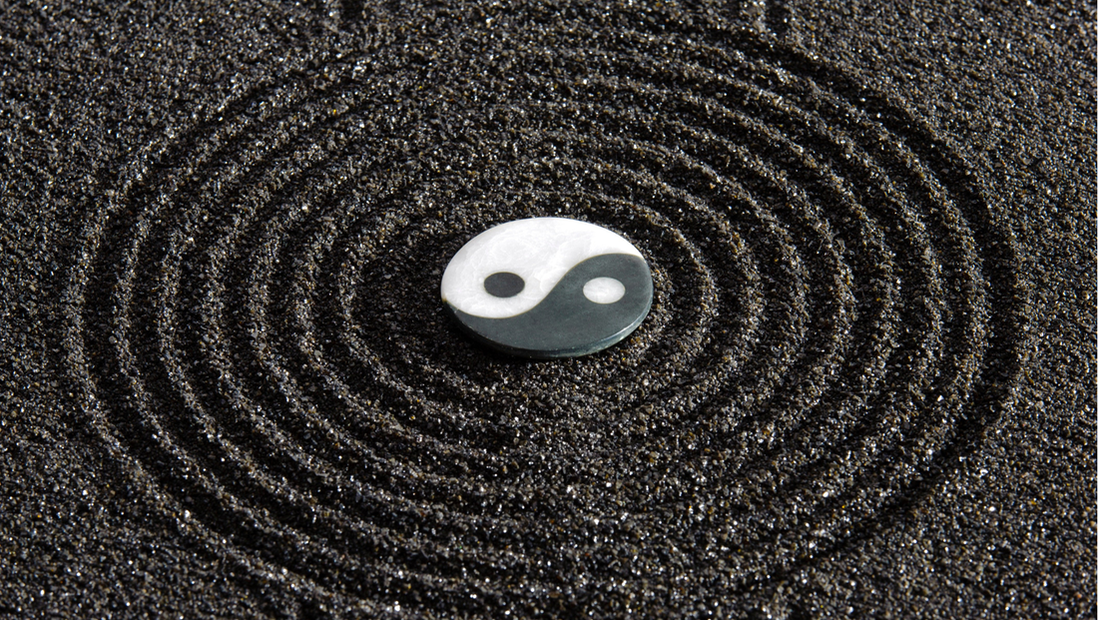
Format:
States of Matter is designed to a be a highly-portable, highly-configurable live performance theater/concert event. Requiring no more than five people to mount the show (or, up to as many as desired), States of Matter is as comfortable in a cabaret or blackbox setting as it is in larger venues, such as theaters or outdoor arenas. The songs may be sung "as is" (in concert-style), or else blocking and other dramatic devices (props, costumes, lighting) may be added to enhance the show’s more theatrical aspects. The show has narrative and thematic elements, but no spoken dialogue. Its positive message and cathartic resolution make it well suited to programs featuring inspirational or spiritual curriculae. By using music as the show’s sole conveyor, the goal is that the audience experience its emotional impact in its most direct fashion. A summary of the show's plot may be provided as program notes during live performances, as an option for those among the audience who wish a more explicit explanation of the story they are about to experience.
Age-range: 20+ years (all characters)
Voice style(s): Pop/Rock; Contemporary Musical Theater, Close-Harmony Jazz
Other skill requirements: Ballroom dance, Tap dance ("Rhythm")
List of Numbers:
Act One:
- Just One Look (COMPANY)
- Another Sunrise (HEART)
- No Need to Hide (MUSIC)
- The Feeling (SOUL & COMPANY)
- Call of My Life (RHYTHM & COMPANY)
- Dreaming Your Way (HEART)
- Soliloquy (RHYTHM)
- What Would You Do (MUSIC, HEART)
- When Tomorrow Comes (SOUL)
- Find the Sun (RHYTHM, MUSIC & COMPANY)
Act Two:
- The Leap of Faith (COMPANY)
- With Wings to Fly (HEART)
- Trying to Find Some Peace of Mind (MUSIC)
- You Can Make Me Smile (RHYTHM)
- Walking Away (SOUL)
- Swing (COMPANY)
- Nocturne (MUSIC)
- Here and Now (RHYTHM, HEART)
- Rain (SOUL & COMPANY)
Production Stills:
STATES OF MATTER 2000 - ORIGINAL PRODUCTION & CAST
SOM 2000 - Fiona builds an airplane
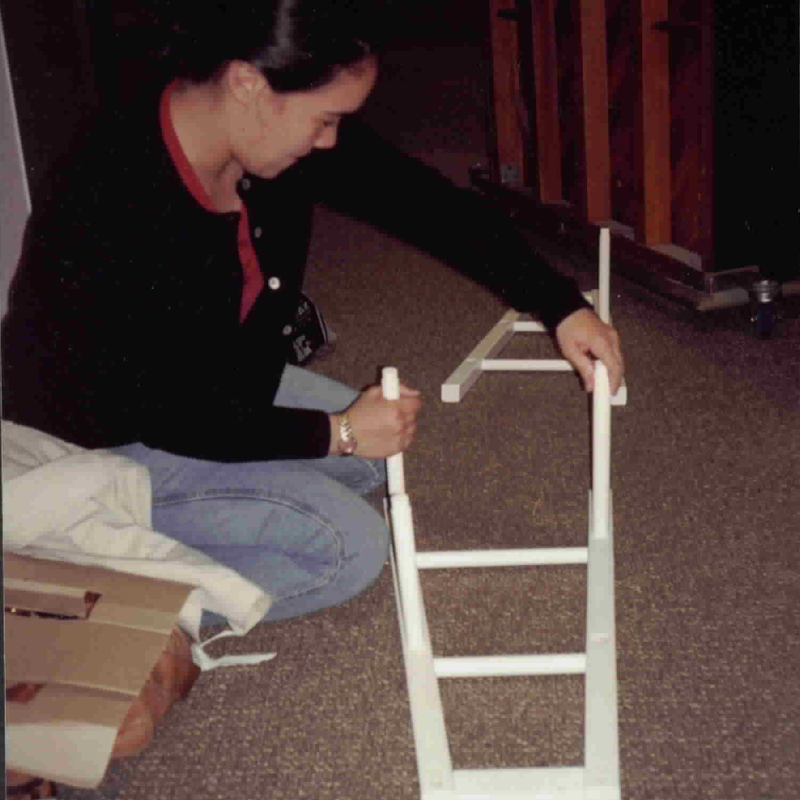
SOM 2000 - Some assembly required
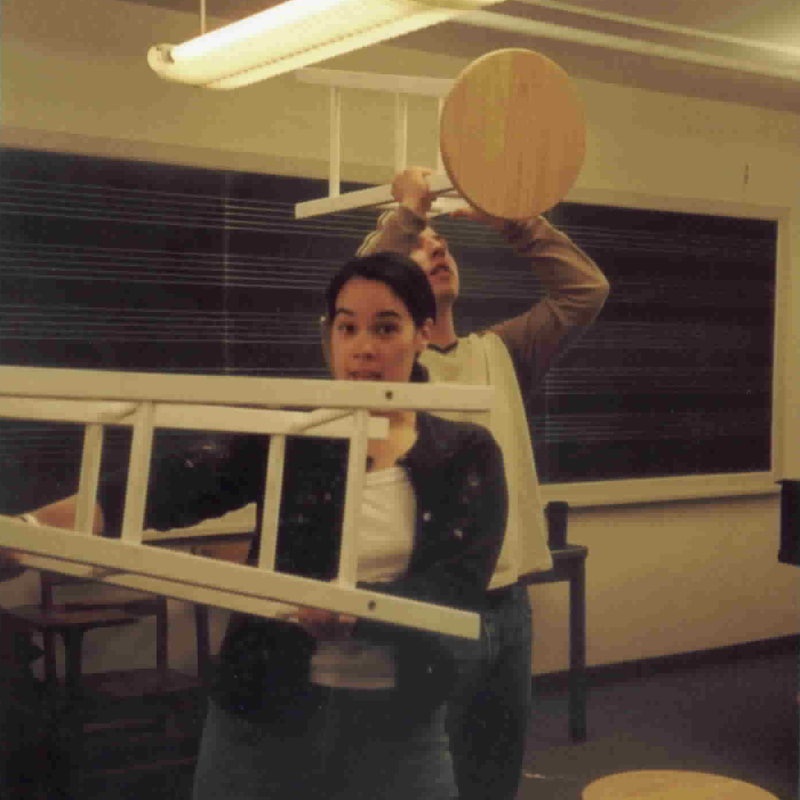
SOM 2000 - Tech week brainstorm session
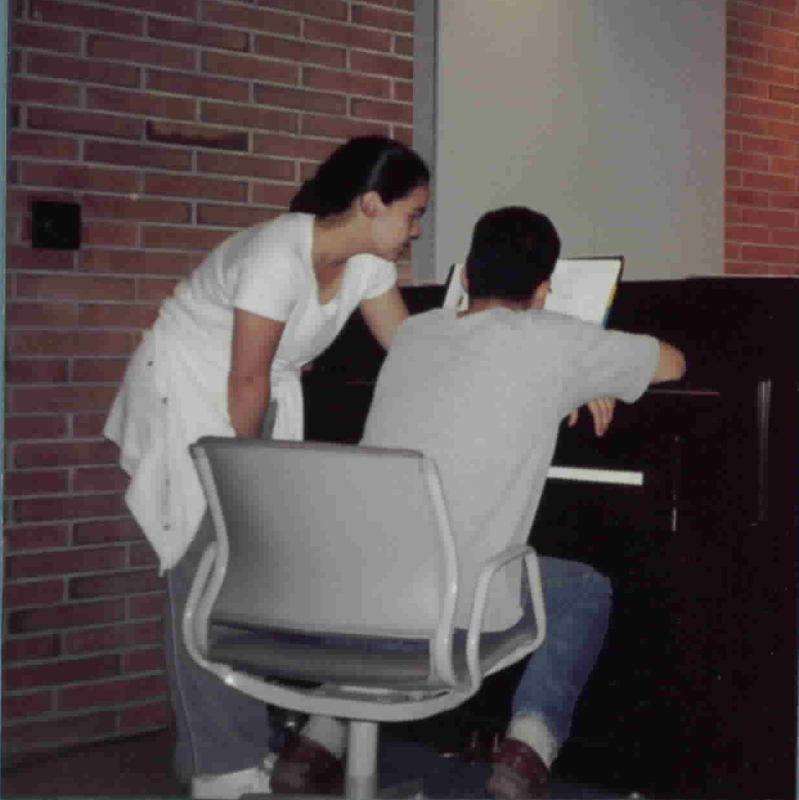
SOM 2000 - Tech week brainstorm session
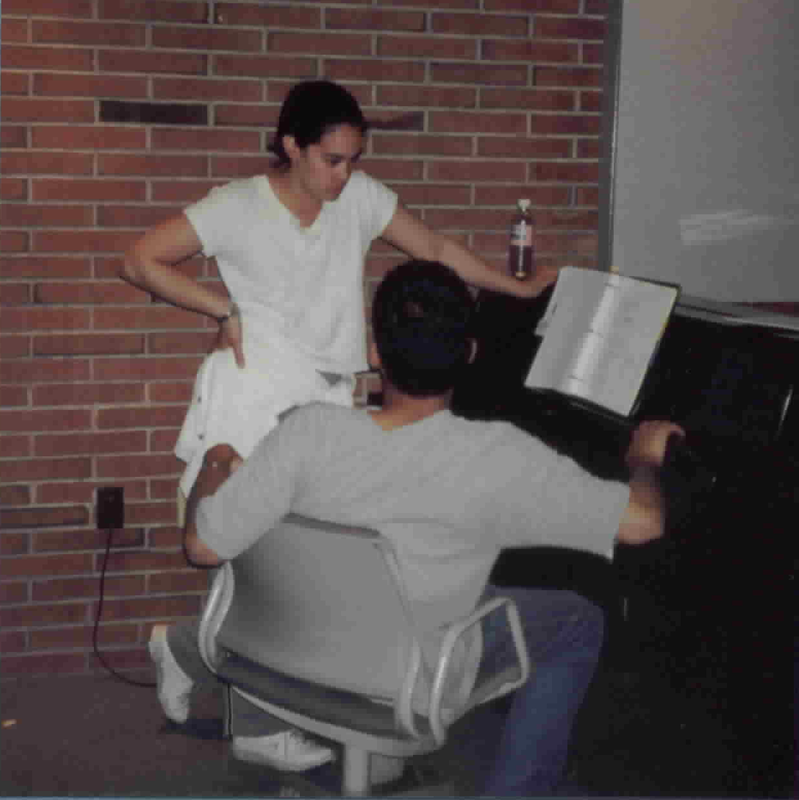
SOM 2000 "Memory and Visitations, Part One"
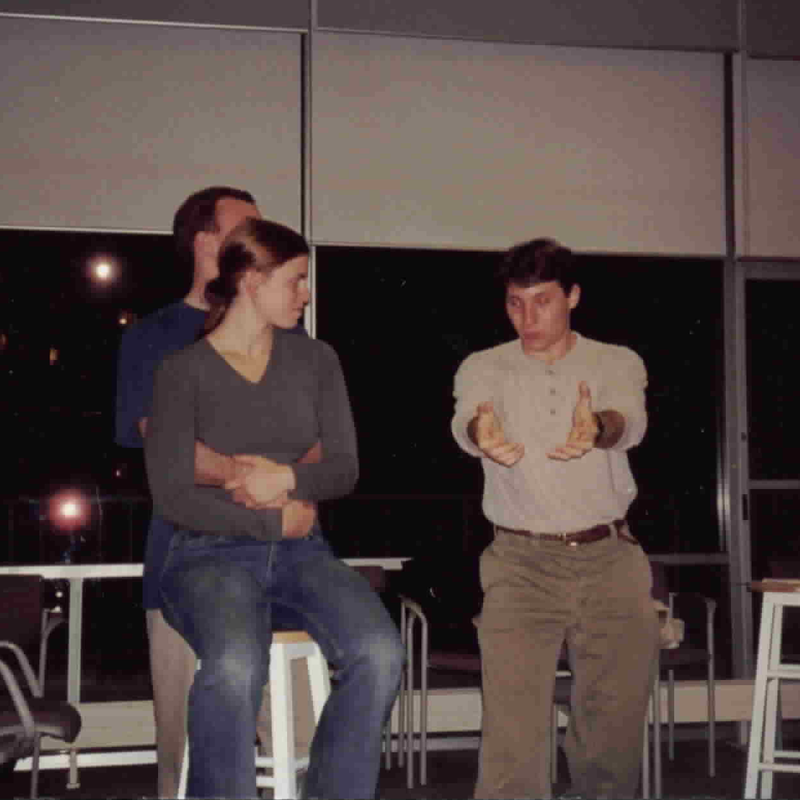
SOM 2000 "Memory and Visitations, Part One"
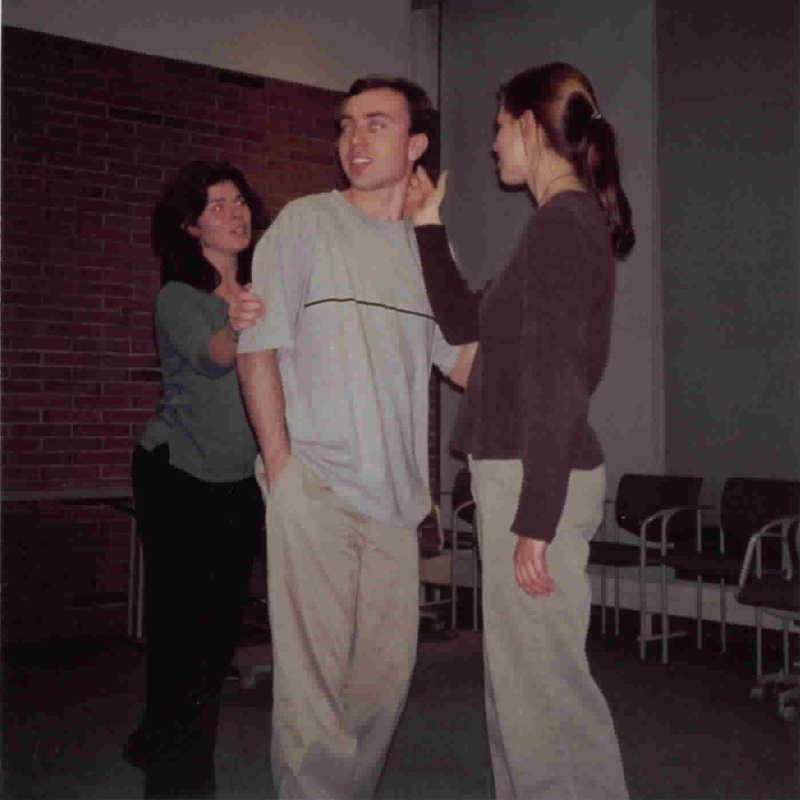
SOM 2000 "With Wings to Fly"
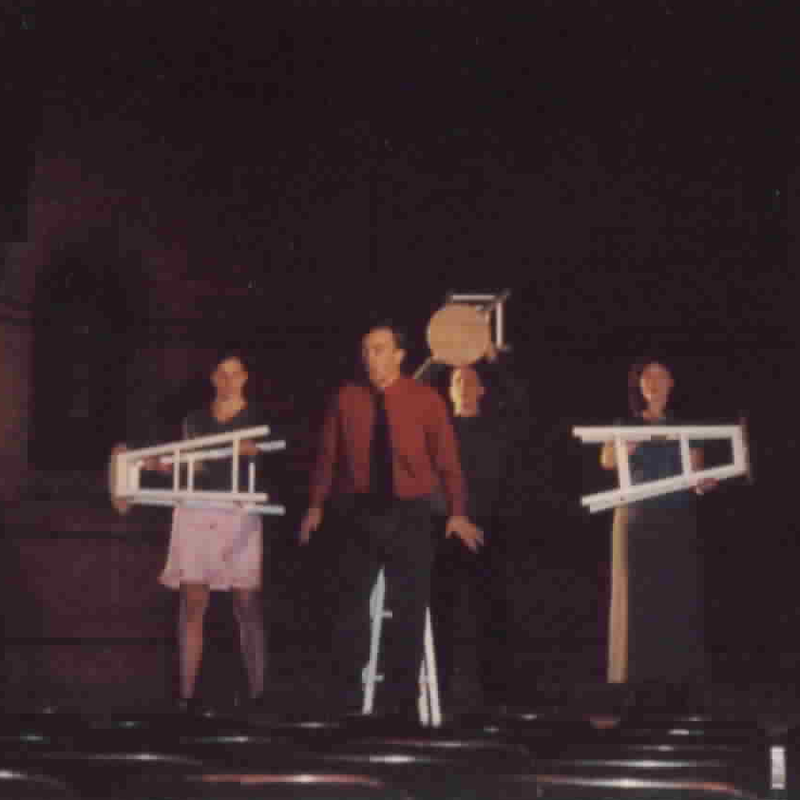
SOM 2000 "You Can Make Me Smile"
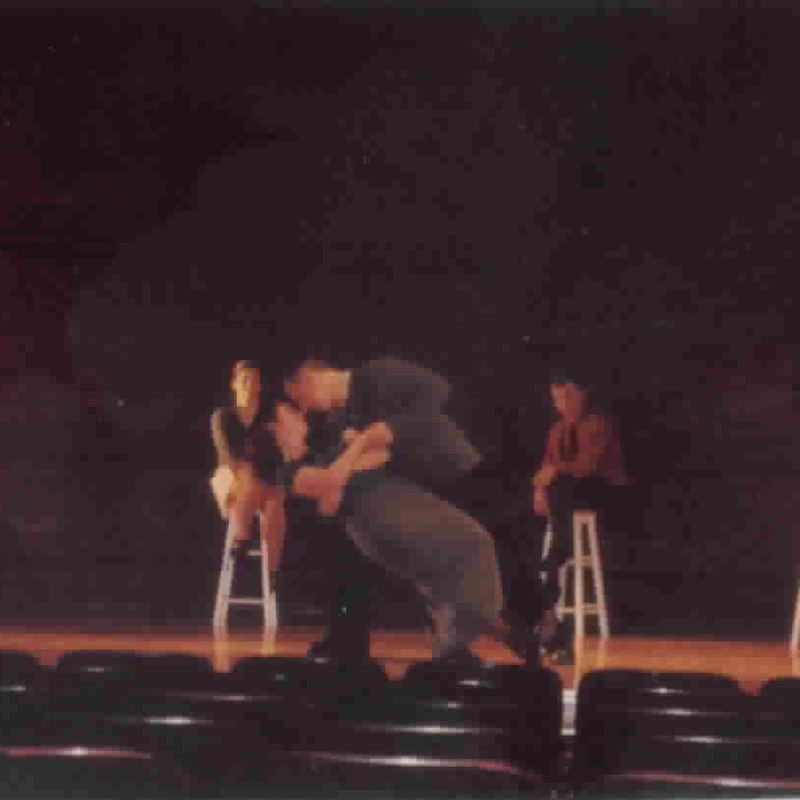
SOM 2000 "You Can Make Me Smile"
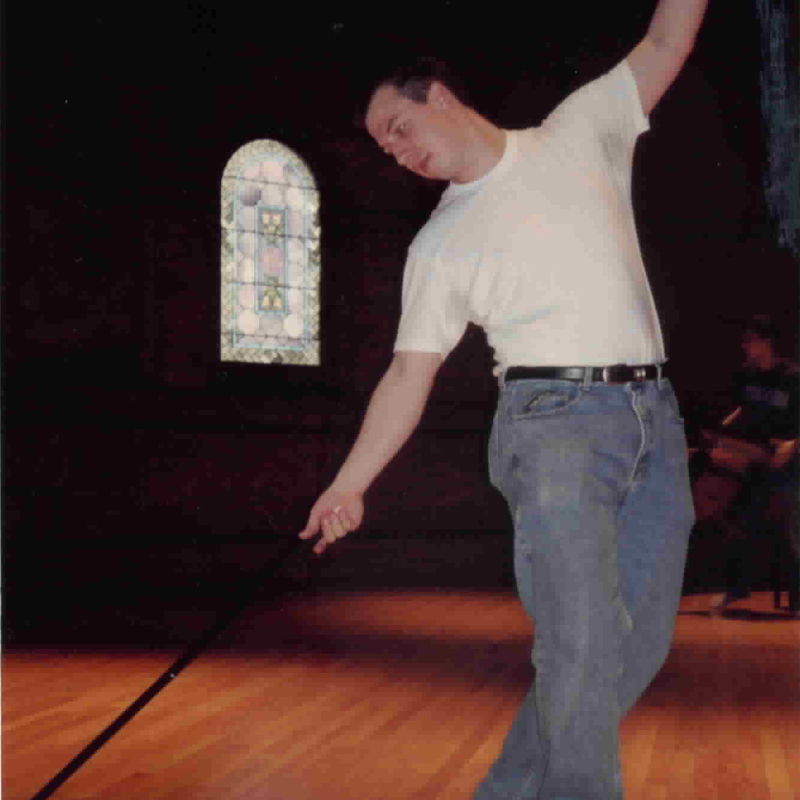
States of Matter 2000 Cast, from left to right: Jennifer MacDonald, Bill Meakem, Elizabeth Geuss, Steven J. Engelbrecht
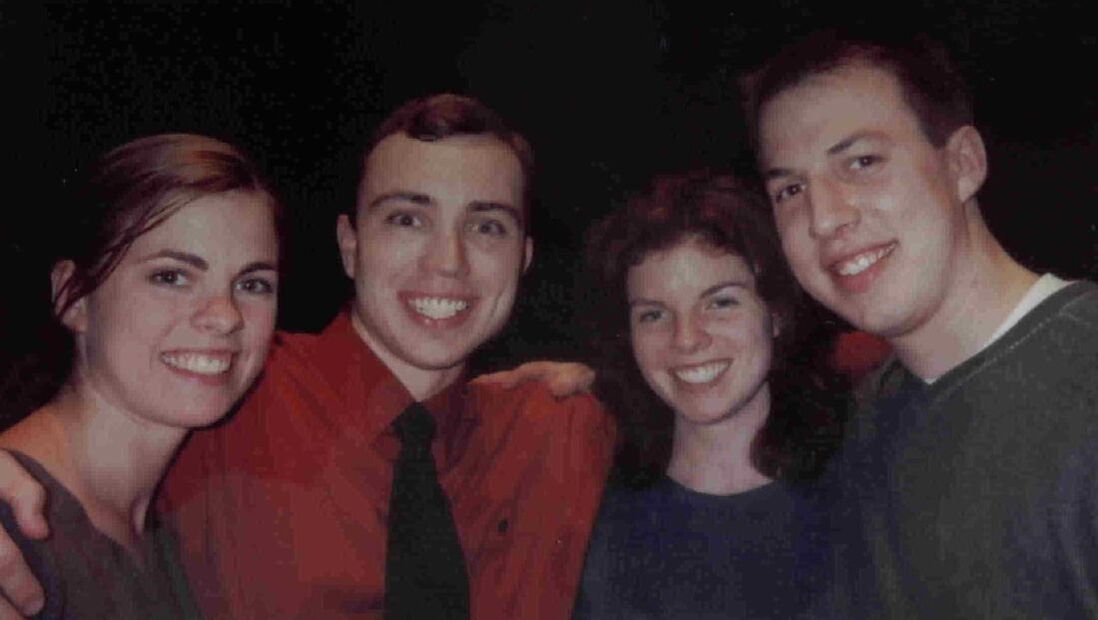
STATES OF MATTER 2000 - ORIGINAL LOGO DESIGN:![]()
Design by: Edmund Quirin (2000)
STATES OF MATTER 2000 - PROGRAM DESIGN & PRODUCTION CREDITS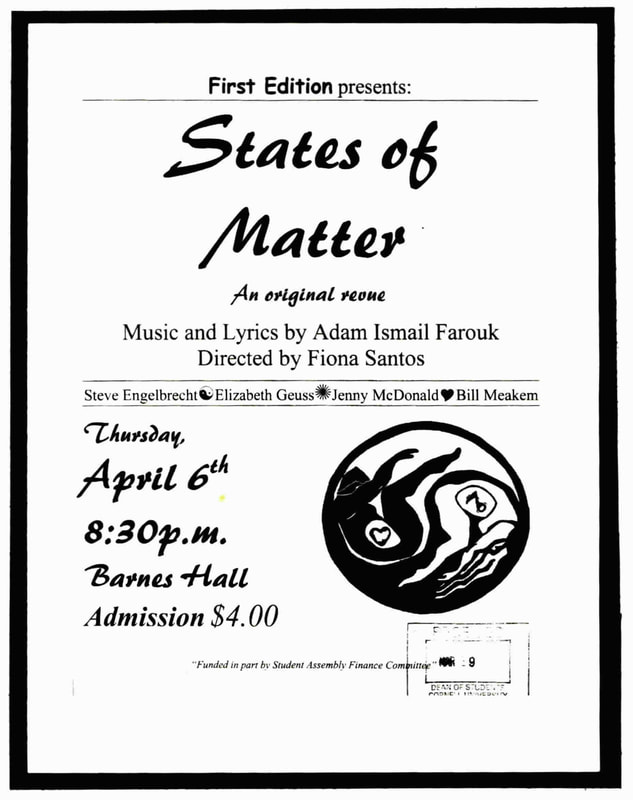
Production Credits:
Heart: Bill Meakem
Music: Jennifer MacDonald
Rhythm: Steven J. Engelbrecht
Soul: Elizabeth Geuss
Music & Lyrics by: Adam Farouk
Directed by: Fiona Santos
Stage Management by: Jason Brantman
Lighting by: Amanda Pearl
Sound by: Todd Hutchinson @ Calf Audio
Produced by: Edmund Quirin
Invaluable Assistance:
Rice Majors, Vin Shende, Scott Tucker
